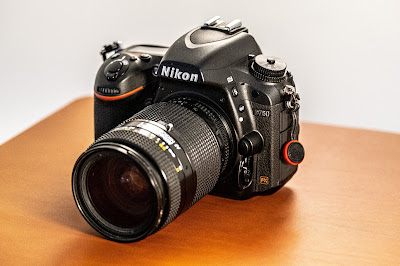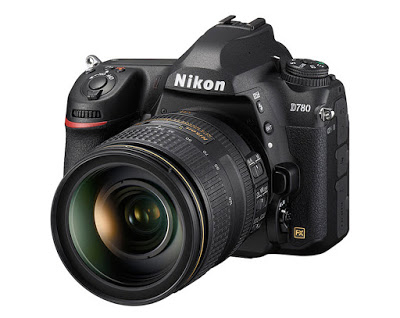Nikon D750 review
My copy of the D750 has been with me now for several years, and I think I have enough experience with the camera to give my thoughts on the good and the bad about this camera. It is not going to be a complete or an exhaustive review covering all corners of the D750 but some highlights that I as a happy enthusiast have encountered. I suggest you check the full specs of this camera and of course other reviews if you are considering to buy the D750.

History
Back in September 2014, Nikon released the D750 camera and back then the retail price was around 2399 dollars. In late 2019, the camera was offered on black Friday sales for prices as low as 1000 dollars, and some comments on various blogs suggest the price was even lower than that (USD 699). So a significant price drop since the introduction of the camera. The D750 is also an aging camera body and the professionals seem to go for the mirrorless camera bodies with the release of the Z6 and Z7’s. But my copy has been with me now for several years despite the fact that I also own several mirrorless cameras. So maybe the D750 could be a good enthusiast camera for you. But let’s start to look at what you will not get if you buy the D750 and then afterwards dive into what you will get.

What the D750 will not offer
I have noted a few things on my list of things that I miss. It is not a comprehensive list – it is just what I have found relevant.
No 4K Video
First of all, if you are a video or hybrid shooter with the ambition to make 4K video, then the D750 will disappoint you. It only does 1080, but it does so very well. However, 4K it is not.

No IBIS
If you drink too much coffee like me or simply would like to shoot with a slow shutter speed without getting blurred pictures due to camera shake, then the D750 itself cannot help you. There is no in body image stabilization. You can get F-mount lenses with built in stabilization but the body itself has no stabilization.

LCD screen flexibility
The LCD screen is not fully articulating – it only flips up or down, and the LCD is not touch sensitive, meaning that zooming in and out is done via pushing buttons. I think you can get used to it, but I use swiping and pinching all the time on my smartphone, so I do miss it on the D750.

Auto focus system
The auto focus system is very good and I understand it is the same system that sits in the big brother the D810. But measured towards a modern mirrorless camera, the 51 focus points and the fact that they sit very much toward the centre of the frame, cannot match a modern mirrorless where you easily find several hundred focus points and covering most of the frame. Also, the advanced AF systems with eye detect is not part what the D750 has to offer.

Optical viewfinder gives limitations
As this is a DSLR, there is no focus peak or focus zoom option to help you focus with a manual focus lens. The D750 has a little indicator in the bottom left of the optical viewfinder, but it not as easy to use as the focus peak systems where you can almost see the focal plan walking back and forth as you change focus.

Likewise the full blown level indicator is only available in live view – it is not to be seen in the optical viewfinder. However, you can re-assign the PV button (sits on the front of the camera, top right just below the AF assist illumination) via the CUSTOM SETTINGS MENU item f3, “assign preview button” to “viewfinder virtual horizon” which will give you a level indicator in the bottom of the viewfinder, just above the exposure meter. You can also assign the f2 button to do the same – see the manual page 359.
Not exactly quiet
Quiet operation is not a D750 stronghold, on the contrary it seems like the D750 enjoys to be loud and noisy. It has a so called quiet mode, but it is really not very quiet at all!
ISO button
A dedicated ISO button on top of the camera would be nice. You can re-program the video record button on top of the camera to act as the ISO button, but for reasons beyond me, it also activates the LCD which is a bit annoying if you are using the optical viewfinder.

What you do get!
With all the negative stuff out of the way, let’s look at the positive with the D750. First of all, this is a very good camera for stills. I know the megapixel war is on and that 24MP may be is in the low end of the scale today, but many manufacturers have 24MP or thereabout as a sweet spot for good and sufficient resolution. Unless you print very large or want to crop heavily, I think you as an enthusiast will find that the resolution the D750 offers is more than enough. On top of this the D750 is a full frame camera and the colour rendition is great, even the JPGs I find to look amazing straight out of the camera. And don’t take my words for it, if you google among written reviews or benchmarks, the D750 is still a top performer.





Low light performance
Add to this the low light performance of the D750 is outstanding. This camera sees in the dark and this is the case for both the sensor and the auto-focus system. I know that some will argue that photography is writing with light and the low light performance is irrelevant – they will argue that I should buy a flash, but I like low light and low key photography. None of my other cameras that all are mirrorless can compete with the low light performance of the D750 in my humble opinion. And I have several times in post processing recovered details that I could not see with the naked eye when I took the picture.


Ergonomics
A third area where I enjoy the D750 especially in compare with the mirror-less is in terms of ergonomics. The body is feels solid, it is weather sealed, the grip is deep, most buttons and dials sit where they should. AND the battery life is outstanding. I have never bought a grip for my D750 for the simple reason that one battery can last for a full day of shooting. Not so with the mirror-less – I think it has to do with the power required to feed the electronic viewfinder.

Start up time
On the note of benchmarking towards the mirror-less cameras, I simply enjoy that this camera is ready to go in no time. When I do street photography, I sometime miss a situation simply because the mirror-less camera takes a few seconds to be ready. It is like booting a computer or starting your television set – it takes a little while to be ready. Not so with the D750 – it is ready in no time. I miss that so much on my mirror-less systems!
Back-up of your pictures
Another thing that is important to some is the fact that the D750 has dual card slots. For event shooters, this is key. And to me this also is a strong signal that Nikon back in the days when this camera was launched knew, that many professionals would consider this camera due to its many qualities and the price point. The dual card slot was the little extra thing that made professionals go for the D750 even though it probably was targeted for the serious enthusiast.

Good glass and plenty of it
The D750 has Nikons old F-mount lens interface that has been around since Donald duck was an egg. Nikons new interface for the mirror-less world is the Z-mount and I doubt that we will see many new lenses in the future for the F-mount from Nikon as such. Maybe from 3rd party vendors like Sigma or Samyang. But the amount of both 2nd hand and new glass and lenses for the F-mount system is huge and you can on a budget get hold of used glass that for other systems would break the bank. You may not get the latest and greatest in terms of coating and super silent and fast focus motors, but if you shoot for example landscape or flowers or macro, I doubt that you will miss it.

And if you buy the right glass with screwdriver auto-focus, you can enjoy the comfort of auto focus via the motor that is built into the D750 camera body.

Etcetera…
There are many other things I could mention regarding the D750 like a built in flash, WiFi, it is well equipped with connectors…

Conclusion
And as you have guessed it is a camera that I am very pleased with. I think it has served me well. If you are considering to go for the D750, you should of course also look to the competition within the Nikon line-up, look to the levels below (D610) and the levels above (D810 + D850). You should also consider some of the competition – I think Canon recently has released the EOS R which price point wise is getting closer to the D750, but the problem for the mirrorless Canon is that there is very little glass out there. But of course that will change over time. And I definitely think the Canon should be on your short list of cameras to look into.
Don’t worry, be a happy shooter
I guess we all like to make informed decisions and the right decisions relative to our decision criteria’s and personal preferences. But I just want to make a little point towards the end of this review, as I can see that a lot of the traffic on my blog and channel relates to camera and gear selection and decisions. And that is all fair. I think we all want to make informed decisions it is natural that we want to spend some time on making the right choices in terms of camera. But don’t overdo it. Don’t spend too much time on a an article like this one. Spend the time on getting out there and taking some great photos!
Shopping link
Affiliate link to the Nikon D750 (body only).
Related reading
Nikon D750: Why I chose the D750 in 2018 for stills





